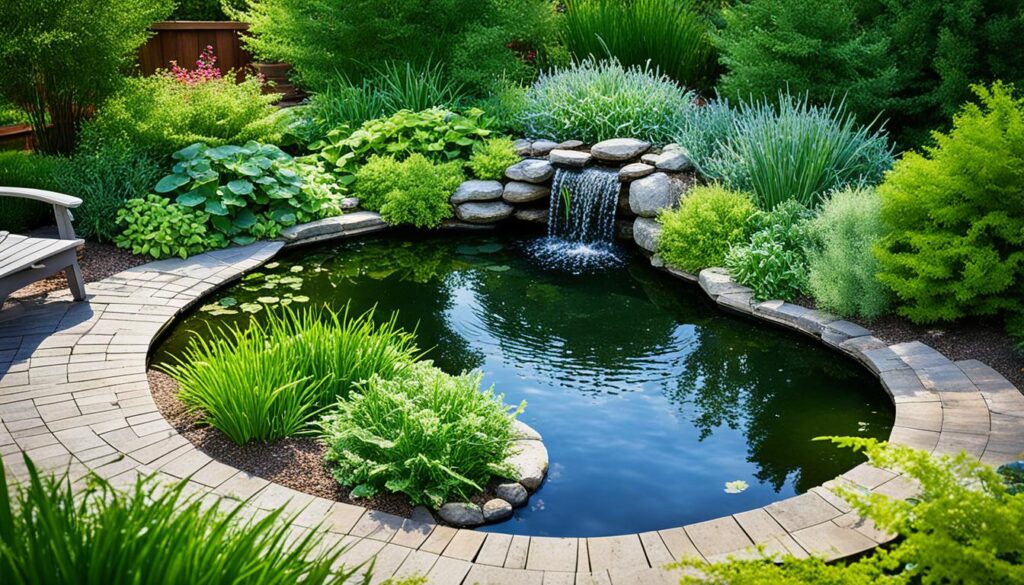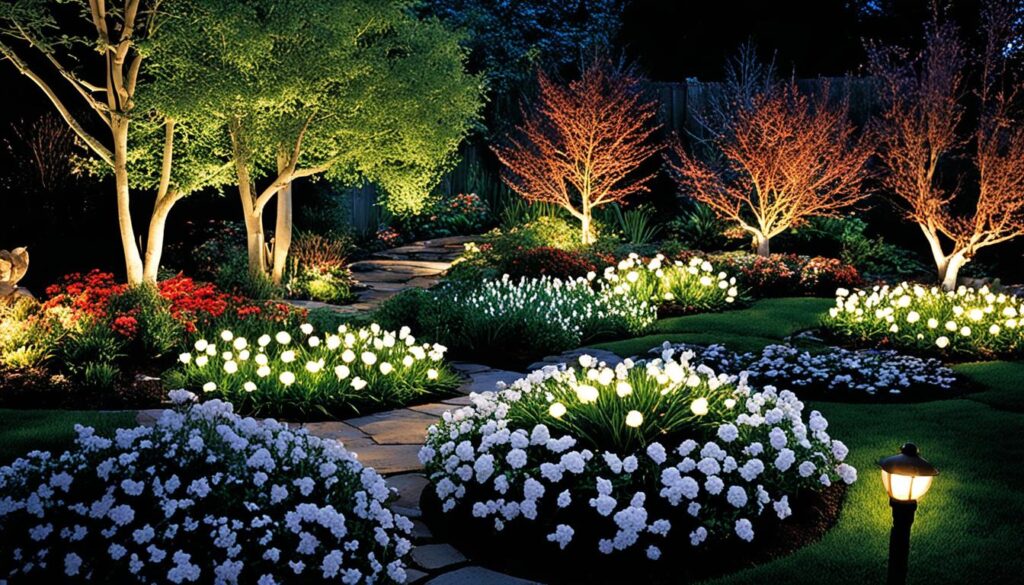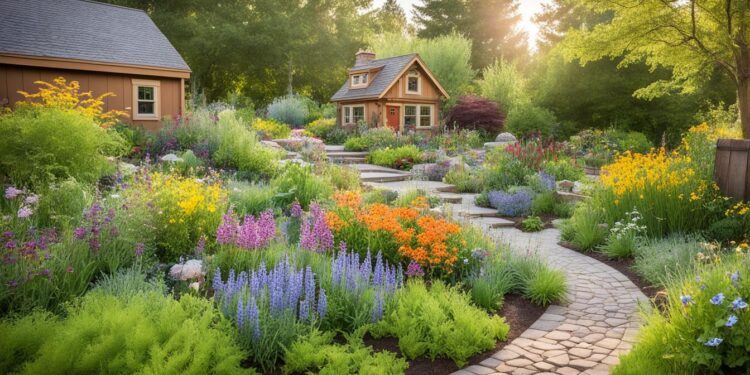Do you want to turn your backyard into a haven for local wildlife? You’ve come to the right spot! This guide will teach you how to make a garden that looks great and helps the environment.
By using native plants and adding water sources, you can make a place where animals feel welcome. It doesn’t matter if you’re new to gardening or have been doing it for years. This article will give you the tips and steps to create a beautiful, nature-filled garden.
You’ll find out how to attract pollinators and give them a place to live and nest. Imagine seeing birds, butterflies, and other creatures enjoying your garden. Get ready to start a journey in sustainable gardening and caring for the environment.
Attracting Beneficial Animal Visitors
Creating a wildlife-friendly garden is more than making it look good. It’s about building a home for many kinds of local wildlife. To draw in helpful animals, we need to know what they need and give it to them.
Understanding the Needs of Local Wildlife
Animals need different things like food, water, and places to live. By learning about the animals in your area, you can make your garden perfect for them. This means planting native plants that give food and water, and adding places for water and different kinds of spots to live.
Incorporating Shelter and Nesting Areas
It’s important to give animals places to hide and nest. You can do this by putting up birdhouses, making brush piles, or leaving some areas wild. This way, you help many animals, like birds, butterflies, and small mammals, feel safe and at home.
The more varied your garden is, the more animals it can attract. By knowing what animals need, you can make your garden a great place for many helpful animals to live.
Selecting Native Plants for a Thriving Habitat
The key to a wildlife-friendly garden is choosing the right plants. Using native plants makes your garden rich and full of life. These plants are perfect for your area’s climate and help local wildlife.
Think about what local wildlife needs when picking plants. Native plants give food, shelter, and homes to many animals. By picking different native plants, you help many creatures live in your garden.
Native plants also fit well with your area’s weather and soil. This means they’re easy to care for and good for the planet. By using native plants, you make a garden that’s healthy and needs little care.
Providing Water Sources for Animal Hydration
Creating a wildlife-friendly garden means more than just giving shelter and food. It’s also about having a steady supply of clean water. By adding bird baths and backyard ponds, you can draw in many thirsty animals to your garden.
Installing Bird Baths and Ponds
Bird baths are a great way to offer water for birds. Pick a shallow one with sides that slope gently so birds can easily get in and out. Place it in a shaded spot, away from where people walk, to keep the birds safe while they drink and bathe. For a natural look, think about adding a small pond or water feature. These can be drinking spots and places for animals to cool off when it’s hot.
Ensuring Clean and Accessible Water
Keeping your water sources clean is key for wildlife. Clean and refill birdbaths and ponds often to stop algae and debris from building up. Also, make sure the water is easy to get to by keeping the area around it clear. This lets birds, small mammals, and amphibians safely get to the water they need.
By focusing on water for wildlife in your garden, you make a welcoming and healthy place for many animals. These water features help animals by giving them water to drink and a spot to bathe. They’re essential for the health and variety of your garden’s ecosystem.

Creating a Pesticide-Free Environment
Making a pesticide-free garden is key to a healthy, wildlife-friendly space. By using organic pest control, gardeners keep plants and animals safe. This method helps your garden’s ecological balance and supports sustainable gardening.
Exploring Organic Pest Control Methods
Encouraging beneficial insects is a great way to fight pests without chemicals. Ladybugs, lacewings, and praying mantises eat common garden pests. By planting native plants that attract these insects, your garden can balance itself naturally.
Physical barriers are another good way to control pests organically. Organic mulch, row covers, or sticky traps can keep pests away from your plants. Natural repellents like garlic, pepper, or essential oils can also keep pests off without harming your garden’s ecological balance.
Using these organic pest control methods helps keep your garden healthy and supports local wildlife. It makes for a vibrant, sustainable gardening space.
Establishing Animal-Friendly Pathways
Creating pathways that animals love is key to a wildlife-friendly garden. Use log piles, brush piles, and gravel or mulch paths to help small creatures move easily through your garden. These paths make your garden a better place for wildlife and improve its look and feel.
Log or brush piles are great for shelter and hiding spots for many animals. They keep wildlife safe as they move through your garden. Adding gravel or mulch paths makes it easy for animals to get around without getting hurt.
With these features, your garden becomes a welcoming place for wildlife. It’s a step towards a lively, nature-filled backyard. Whether you want to attract birds, butterflies, or small mammals, easy pathways are essential.
Incorporating Animal-Friendly Lighting
Creating a wildlife-friendly garden is more than just planting native plants and offering water. It’s also important to think about how lighting affects the local ecosystem. The wrong kind of lighting can mess with the natural habits of night and twilight animals, hurting their health.
To make your garden lighting safe for animals, use motion-activated lights that only light up when needed. Choose lamps that shine down, not up, to cut down on light pollution. Pick bulbs with a warm color temperature (around 3000K or lower) since they’re easier on animals’ natural sleep cycles.

By adding these animal-friendly lighting features, you can enjoy your garden at night without harming the animals that live there. Even small changes in your lighting can greatly help the local ecosystem. This can lead to a healthier, more diverse group of wildlife.
Balancing Wildlife Needs with Human Enjoyment
Creating a wildlife-friendly garden means finding a balance between nature and your own fun. By setting aside quiet spots and places to watch wildlife, you help humans and animals live together well. This way, your backyard becomes a home for many species.
Designating Quiet Zones and Observation Areas
Setting quiet zones in your garden is key. These areas let wildlife live without human bother. They’re perfect for nesting, eating, and resting. Observation areas let you watch the garden’s beauty without disturbing the animals.
When designing your garden, think about paths and seats that keep people away from quiet zones. This lets visitors watch wildlife from afar. It’s good for the animals and makes your time in the garden more special.
By balancing your fun with wildlife needs, you make a garden that celebrates living together with nature. This smart garden design supports both humans and wildlife. It also lets you enjoy the quiet spots and places to watch wildlife you’ve made.
Engaging the Community in Wildlife Conservation
As a passionate gardener, you can inspire and educate your community. Share your knowledge and experiences to protect the local ecosystem. This helps with environmental stewardship.
Hosting educational workshops or garden tours is a great way to engage your neighbors. Teach them about native plants and how to help local wildlife. Show them the benefits of organic pest control too.
These hands-on learning chances can help residents make their yards better for wildlife. It’s a way to support many species.
Working with local schools or groups can also help. Start wildlife-friendly gardens together. This builds community and teaches the importance of protecting nature.
Such projects can inspire others to make their yards wildlife-friendly too. It’s a powerful way to make a difference.
Think about organizing clean-up events or habitat restoration projects. These activities make the area look better and help people connect with nature. They feel proud of their environment’s health.
By working together, you can make your community stronger. Protecting the local ecosystem helps everyone.
Every small step in making a garden wildlife-friendly counts. By getting your neighbors involved, you help protect our natural habitats. This is key for our ecosystems’ health.
Maintaining and Adapting Your Wildlife-Friendly Garden
Keeping a wildlife-friendly garden is a long-term job. It needs regular changes and a commitment to the animals’ needs. By adapting over time, your garden will stay a safe place for animals for years.
It’s key to keep your garden healthy with tasks like pruning, mulching, and weeding. Watch your native plants to know when to trim or thin them. This keeps good spots for nests and food for animals. Mulching helps plants stay moist, fights weeds, and gives insects a home.
Seasonal changes mean your garden care must change too. In spring, clean up winter debris and adjust watering for waking animals. Summer brings the need for shade and water to help animals stay cool. In fall, leave leaves and seeds to feed and shelter animals through winter. By following nature’s cycles, your garden will always be a lively, green space.







